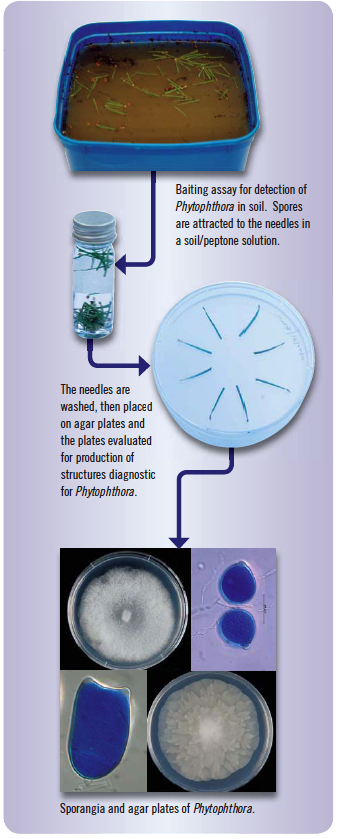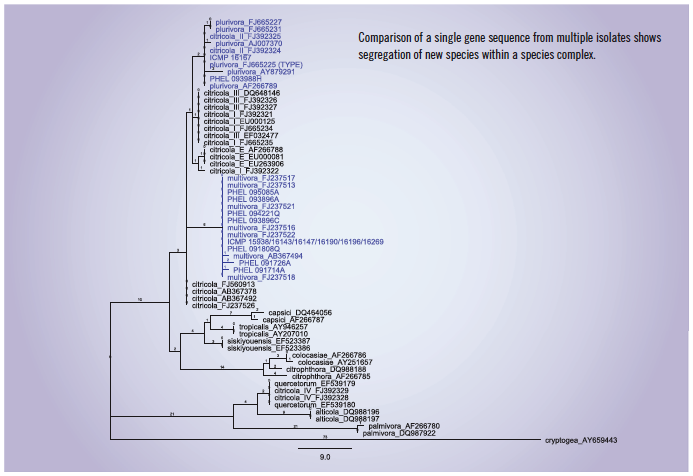PESTS AND DISEASES OF FORESTRY IN NEW ZEALAND
Spotlight on new species of Phytophthora
From Biosecurity 97, April 2010.
The death of kauri trees caused by Phytophthora has attracted attention recently. But why do there seem to be so many “new” species of this water mould?
News of the kauri deaths followed cases in the United States and Europe of “Sudden Oak Death” caused by Phytophthora ramorum. Meanwhile, in the United Kingdom Phytophthora kernoviae has caused disease in several hosts and is associated with diseased cherimoya in New Zealand.
 What biosecurity risk does this group of organisms pose for New Zealand?
What biosecurity risk does this group of organisms pose for New Zealand?
Although previously classified with fungi, Phytophthora are actually more closely related to diatoms and algae. The common name “water mould” refers to the fact that they are usually found in wet conditions. The name Phytophthora derives from the Greek words, phyto meaning “plant” and phthora meaning “destruction”.
These organisms are generally considered to be soil inhabitants but some species also cause damage to the aerial parts of plants. More than 30 species of Phytophthora are present in New Zealand, and they infect a wide range of hosts including native plants, ornamental and horticultural crops, and forestry hosts.
The first species of Phytophthora to be described, P. infestans, was the organism responsible for the potato famine in Ireland in the mid-19th century, and continues to cause disease worldwide. P. infestans was first described in 1876, and since then more than 200 species of Phytophthora have been described worldwide, including 35 since 2000.
Recent descriptions of new species often rely on DNA-based technology and comparison of gene sequences between species. In this way, some species formerly lumped into a “species complex” are now being separated into two or more new species.
For example, P. citricola was described in 1927 from diseased orange trees in Taiwan. Subsequently this species was first identified in New Zealand in 1938 in hops. It has since been found on various hosts in New Zealand, including apple, avocado, bean, boxwood, cherimoya, citrus, grape, kiwifruit, olive, pohutukawa and ribbonwood (manatu).
Using molecular techniques, an isolate identified initially as P. citricola was found by scientists at Crown Research Institute Scion to represent the newly named species Phytophthora plurivora. A number of isolates of P. citricola were then re-evaluated by MAF Biosecurity New Zealand (MAFBNZ) Plant Health and Environment Laboratory (PHEL).
By analysing gene sequences from these isolates, it was discovered that some of the isolates were actually two recently described species within the P. citricola complex: P. multivora and P. plurivora. This means that these “new” species are now considered to be present in New Zealand.
Phytophthora species can attack some native plants in addition to kauri. Phytophthora species have been found on kahikatea, karaka, pohutukawa and puriri, among others. PHEL is also investigating wilt and dieback of kawakawa in the Auckland region.
Various Phytophthora species are associated with symptomatic plants but further testing is required to determine which of the species is responsible for causing disease.

Between 2000 and 2009, PHEL identified more than 20 Phytophthora species on 78 different hosts sent from throughout New Zealand through MAFBNZ’s passive surveillance programme. Isolation and identification of these species has generally involved use of a baiting assay, a time-consuming process. Molecular methods are used to refine identification once a pure culture of Phytophthora is obtained.
To increase the speed and sensitivity of detection in plant samples, a real-time polymerase chain reaction (PCR) assay is being developed by PHEL to detect a wide variety of Phytophthora species. Currently, this assay can detect more than 20 species of Phytophthora from pure cultures. The assay will be tested against infected plant material and will become a screening tool for samples suspected to contain Phytophthora.
Information obtained from samples sent through the passive surveillance programme will add to MAFBNZ’s understanding of the prevalence of Phytophthora throughout New Zealand and should allow it to be better informed when new species are reported.
Megan Romberg, Scientist, Plant Health and Environment Laboratory, megan.romberg@maf.govt.nz

 Farm Forestry New Zealand
Farm Forestry New Zealand

